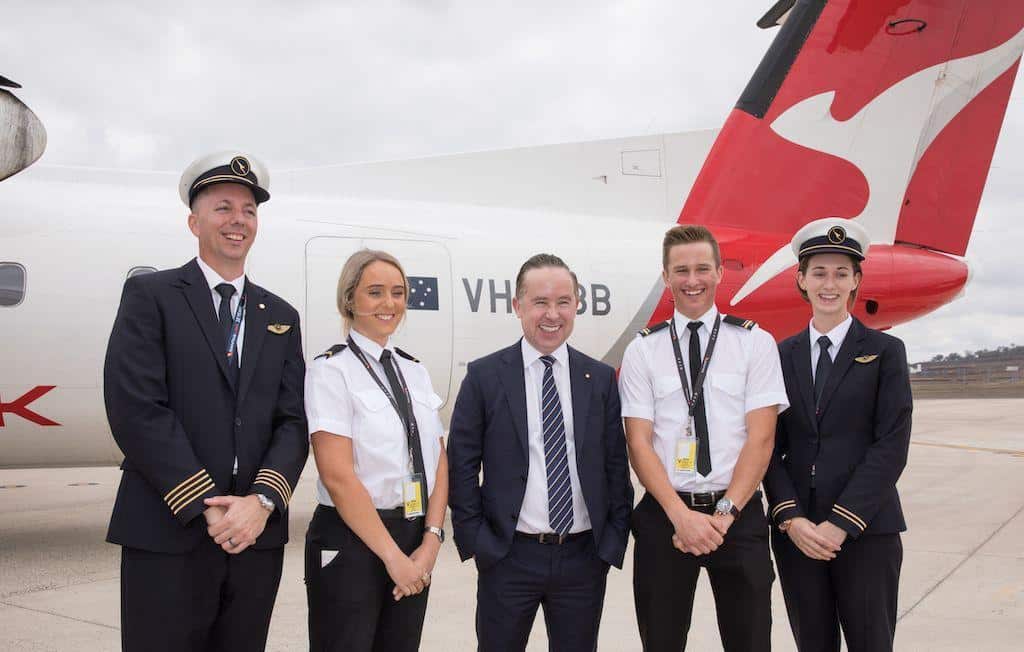As a kid, seeing airplanes fly in the air was really a wonder to behold. Little did we know that human brains are actually behind the production of airplanes and other flying machines.
To be one of the brains behind the production of aircraft and spacecraft, you sure need to undergo some formal academic training.
So, in this post, we’ll be looking at the best undergraduate Aerospace Engineering schools in the World according to their order of rankings.
According to the U.S. Bureau of Labor Statistics (BLS), job opportunities for aerospace engineers were projected to increase by 2% from 2018-2028, which is slower than average.
As of May 2018, aerospace engineers, including aeronautical engineers, made a median annual salary of $115,220, as reported by the BLS.
In this article, put together by the World Scholarship Forum team, we’ll be talking about Aerospace Engineering extensively. Carefully read through!
See the table of contents below.
Table of contents
- What Is Aerospace Engineering?
- What Does An Aerospace Engineer Do?
- How To Become An Aerospace Engineer?
- Entry Requirements Into Aerospace Undergraduate School
- How Long Does It Take To Complete Aerospace Undergraduate Engineering Program?
- How Much Does Aerospace Undergraduate Engineering Program Cost?
- How Much Does An Aerospace Engineer Earn?
- Best Undergraduate Aerospace Engineering Schools In 2023
- #1. Massachusetts Institute of Technology
- #2. Georgia Institute of Technology
- #3. California Institute of Technology
- #4. Embry-Riddle Aeronautical University
- #5. Purdue University–West Lafayette
- #6. Stanford University
- #7. University of Texas – Austin
- #8. Virginia Tech
- #9. University of Colorado Boulder
- #10. Mississippi State University
- #11. University of Minnesota
- #12. University of Illinois – Urbana-Champaign
- #13. The University of Washington
- Conclusion
- FAQs On Best Undergraduate Aerospace Engineering SchoolsIn 2023
- References
- We Also Recommend
What Is Aerospace Engineering?
Aerospace Engineering is an Engineering discipline that concerns the production of aircraft and spacecraft. It is one of the fastest-growing diverse disciplines focusing on designing, maintaining, and developing all types of aircraft.
Furthermore, Aerospace Engineering deals with the design and development of flying machines. This is one of the latest branches of engineering that came into the foray in the 19th century with the first experiments in powered flights.
There are two branches of Aerospace Engineering; Aeronautical Engineering and Astronautical Engineering.
Aeronautical Engineering focuses on designing aircraft such as powered lighter-than-air craft, gliders, fixed-wing airplanes and jets, autogyros, and helicopters.
While Astronautical Engineering focuses on designing and developing spacecraft that fly outside the atmosphere.
In a nutshell, Aerospace Engineering is a division of Engineering that provides skills and knowledge to design, manufacture and maintain spacecraft, aircraft, missiles, and weapons systems.
What Does An Aerospace Engineer Do?
Aerospace Engineers build aircraft, rocket, satellites, and missiles. In addition, these engineers test prototypes to make sure they work according to plans.
Such professionals also design parts and subassemblies for these boats, including engines, airflames, wings, landing gear, control systems, and instruments.
In addition, Aerospace Engineers may perform or write the destructive and non-destructive test specifications for the power, functionality, reliability, and long-term durability of aircraft and parts.
Furthermore, Aerospace Engineers; plan, study, test, troubleshoot, and build an advanced defense, spacecraft, and aviation technology.
They develop standards for quality assurance and design processes, identify problems with products that are not functioning optimally, and fix them.
Duties of an Aerospace Engineer include:
- Developing new technologies for use in spacecraft, aviation, and defense systems.
- Designing, assembling and testing of aircraft and aerospace products
- Analyze damage or malfunction in equipment to find our possible reason and offer a solution
- Assessing the cost and workability of new projects to be undertaken
- Determining quality standard acceptance criteria for design methods, quality standards, sustainment after delivery, and completion dates
- Evaluating that the project or the product satisfies engineering principles, safety norms, customer requirements, and environmental challenges
- Manufactured aircraft and individual components in coordination with the design team.
Aerospace Engineers often take on specific areas of functioning such as software engineering, structural engineering, mechanical engineering, electrical and electronic engineering, for automation and guidance purposes, aerodynamics or propulsion systems.
How To Become An Aerospace Engineer?
In order to become an Aerospace Engineer, obtaining an academic degree is a step in, but it’s not enough. You need to obtain licenses and certifications to be able to practice. To be an Aerospace Engineer, here are the following steps you need to take.
Acquire A Bachelor’s Degree
Aerospace Engineers must have a bachelor’s degree in Aerospace Engineering or any other related aspect of Engineering.
To acquire a bachelor’s degree in Aerospace Engineering, you need to attend Aerospace Engineering undergraduate school.
High school students curious about studying aerospace engineering should take chemistry, physics, advanced math, and computer programming and computer languages.
Bachelor’s degree programs incorporate classroom, laboratory, and field studies in subjects such as general engineering systems, propulsion, stability and control, structures, mechanics, and aerodynamics, which is the study of how air cooperates with moving objects.
Some Aerospace Engineering undergraduate schools offer collaborative programs in partnership with regional businesses, which give students working experience while they complete their education.
Cooperative programs and internships allow students to gain valuable expertise and to finance part of their education.
At some Aerospace undergraduate Engineering schools, a student can enroll in a 5-year program that leads to both a bachelor’s degree and a master’s degree upon fulfillment. Programs in aerospace engineering are accredited by ABET.
Obtain Licenses, Certifications, and Registrations
Licensure for aerospace engineers is not as common as it is for other engineering occupations.
However, it is vital for entry-level positions. A Professional Engineering (PE) license, which permits higher levels of leadership and independence, can be acquired later in one’s career.
Engineers with practice licenses are known as professional engineers (PEs). A PE can supervise the work of other engineers, sign off on projects, and administer services directly to the public. State licensure generally entails the following;
- A degree from an ABET-accredited engineering program
- A passing score on the Fundamentals of Engineering (FE) exam
- Relevant work experience, typically at least 4 years
- A passing score on the Professional Engineering (PE) exam.
The initial Fundamentals of Engineering exams are to be taken after earning a bachelor’s degree.
Engineers who pass this exam are generally known as engineers in training (EITs) or engineer interns (EIs). After meeting work experience terms, EITs and EIs can take the second exam, called the Principles and Practice of Engineering.
It’s also worthy to note that each state issues its own licenses. However, most states recognize licensure from other states, as long as the licensing state’s requirements meet or surpass their own licensure requirements.
Many states require continuing education for engineers to keep their licenses.
Entry Requirements Into Aerospace Undergraduate School
Entry requirements into Aerospace Engineering programs vary according to school. However, to gain entry into a top aerospace engineering school, you need to be highly competent in mathematics and physics to apply.
Furthermore, suppose you’re an international student. In that case, you might need to prove your proficiency in English through a standardized exam such as IELTS prior to commencing the undergraduate program in order to obtain a student visa or entry into the program.
How Long Does It Take To Complete Aerospace Undergraduate Engineering Program?
Aerospace Engineering degrees at the undergraduate level usually last three or four years, but many schools allow students to progress directly into a Masters in Aeronautical Engineering, extending the course length by an additional year or two.
In such cases, BEng and MEng students take the same courses for the first two or three years, and well-performing students then continue with the BEng for one more year or progress to the more advanced MEng for two years.
Some Aerospace undergraduate programs may also allow for this transfer in the first or second year of the BEng degree program, while others allow post-secondary candidates to enroll in an MEng immediately.
A few institutions also offer associate degree programs. Still, these usually are reserved for practicing engineering professionals who have previously been certified in a related field and want to switch careers into aeronautical engineering.
How Much Does Aerospace Undergraduate Engineering Program Cost?
The annual cost of tuition for a bachelor’s degree in aerospace engineering varies according to college.
The tuition can go as low as a little over $8,000 in public institutions to over $45,000 in private universities for in-state students.
For out-of-state students, tuition differs from about $27,000 for public schools to more than $45,000 for private institutions.
On average, the tuition fee for an in-state aerospace engineering degree costs around $10,500 a year; for someone studying out-of-state, the tuition average would be $36,500.
How Much Does An Aerospace Engineer Earn?
According to the U.S. Bureau of Labor Statistics (BLS), job opportunities for aerospace engineers were projected to increase by 2% from 2018-2028, which is slower than average.
As of May 2018, aerospace engineers, including aeronautical engineers, made a median annual salary of $115,220, as reported by the BLS.
Best Undergraduate Aerospace Engineering Schools In 2023
Here’s an outline of the best undergraduate Aerospace Engineering schools in the world in 2023.
These schools were chosen based on the following ranking factors;
- Reputation – This represents the school’s public image and performance in general rankings.
- Accreditation – This shows that a particular school is deemed eligible to undergo a program.
- Graduation Rate – The graduation rate highlights the progress rate of an institution. A school’s ability to graduates actually speaks well about the school.
#1. Massachusetts Institute of Technology
MIT, which comes first in our list of best Aerospace Engineering schools in 2023, is a private institution founded in 1861.
This program is meant to prepare the undergraduate student for an entry-level position in aerospace and similar fields and for further education at the master’s level.
The Engineering Accreditation Commission of ABET accredits the program. The program includes an opportunity for a year’s study abroad.
Through this undergraduate Aerospace Engineering program, students build a conceptual understanding of the foundational engineering sciences and professional subjects that span the topics critical to aerospace.
Furthermore, this learning takes place within the engineering context of conceiving-designing-implementing-operating (CDIO) aerospace and related complex high-performance systems and products.
#2. Georgia Institute of Technology
Georgia Institute of Technology is a public institution that was founded in 1885. It has a total undergraduate enrollment of 16,049.
GIT undergraduate Aerospace Engineering program provides capable, motivated, and well-prepared students with an aerospace engineering education of the highest quality, enabling them to reach their maximum potential in a technological world.
At Daniel Guggenheim School of Aerospace Engineering, research is at the center of everything.
Students learn the theories, simulations, equations, and applications of aerospace engineering by relentlessly questioning them.
The Engineering Accreditation Commission of ABET approves the program.
#3. California Institute of Technology
This Aerospace undergraduate program is meant for students who wish to broaden their knowledge beyond their normal major or who may wish to pursue a graduate program involving aerospace or aeronautical engineering.
The course exposes students to the practical aspect of the discipline through hands-on practical sessions.
In addition to its undergraduate studies, Caltech awards top graduate programs in engineering and areas of science, including biology, chemistry, computer science, earth sciences, mathematics, and physics.
The Engineering Accreditation Commission of ABET approves the program.
#4. Embry-Riddle Aeronautical University
The Bachelor of Science in Aeronautical Science from ERAU prepares graduates for aviation by combining a four-year technical degree with flight training.
Here, students learn to fly, acquire skills in leadership, critical thinking, research, and insight into the industry’s business aspects.
The academic portion of the curriculum encompasses aeronautics, aerodynamics, flight physiology, including high altitude training, and more.
The Engineering Accreditation Commission of ABET approves the program.
#5. Purdue University–West Lafayette
AAE, the nation’s top aerospace engineering program, was ranked No. 4 in the 2020 U.S. News and World Report rankings of aerospace undergraduate programs.
In the junior year, students learn about aerodynamics, propulsion, structures, dynamics, and control systems. Some courses in the junior year are available in both aeronautical and astronautical versions, and students choose the area of primary interest.
In the senior year, students are free to specialize in the following areas;
- Aerodynamics
- Aerospace Systems Design
- Astrodynamics and Space Applications
- Autonomy and Control
- Propulsion
- Structures and Materials
Most of our graduates take jobs in the aerospace industry or pursue graduate work in aerospace engineering.
The Engineering Accreditation Commission of ABET approves the program.
#6. Stanford University
The Undergraduate Program in Aeronautics and Astronautics offers students the chance to learn engineering principles through a project-based curriculum.
The objective of the undergraduate program in Aeronautics and Astronautics is to equip students with the fundamental principles and techniques necessary for success and leadership in the conception, design, implementation, and operation of aerospace and related engineering systems.
Courses in the major introduce students to engineering principles through a project-based curriculum.
Here, students learn to apply this fundamental knowledge to conduct laboratory experiments and aerospace system design problems.
Courses in the major include engineering fundamentals, mathematics, and the sciences, as well as in-depth courses in aeronautics and astronautics, dynamics and control, mechanics of materials, and fluids engineering.
#7. University of Texas – Austin
The University of Texas – Austin is in our list as one of the best undergraduate Aerospace schools.
The University offers a foundational undergraduate curriculum covering engineering and science fundamentals, fluid mechanics, controls, structural dynamics, materials, and more.
With 33 faculty members, over 800 students, and over 4,500 alumni living worldwide, the Department of Aerospace Engineering and Engineering Mechanics at the University of Texas at Austin is a tight-knit, interdisciplinary community that offers programs in aerospace engineering.
The faculty works closely with students to solve important technological and scientific problems related to aviation, space engineering, and science, robotics, energy, solid biomechanics, biomedicine, earth science, and more.
The University of Texas at Austin’s Aerospace Engineering and Computational Engineering undergraduate programs are accredited by the Engineering Accreditation Commission of ABET.
#8. Virginia Tech
Virginia Tech’s Kevin T. Crofton, Department of Aerospace and Ocean Engineering, offers an unusual approach to understanding and utilizing the connections between two seemingly disparate fields.
This perspective allows researchers to forge new paths through aerospace engineering launches graduates into careers that deepen our understanding and advance our technology.
Furthermore, the program inspires students to become critical thinkers, innovators, and leaders with the curiosity and drive to solve real-world problems. The Engineering Accreditation Commission of ABET approves the program.
#9. University of Colorado Boulder
CU Boulder is one of the best aerospace undergraduate schools. The students and faculty are pushing the limits of aeronautics and astronautics research, designing next-generation unmanned aircraft, expanding the possibilities of remote sensing, and building space instruments and satellites for orbit around Earth and beyond.
The institution is home to 56-tenure track, research, and instructional faculty, over 400 graduate students, and 1,000 undergraduates.
The Engineering Accreditation Commission of ABET approves the program.
#10. Mississippi State University
Mississippi State University offers a comprehensive, world-class Aerospace Engineering undergraduate program with the intimacy and opportunity of a small college.
With small informal classes, MSU students have unrestricted access to professors outside the classroom.
The Department of Aerospace Engineering at Mississippi State University presents an accredited undergraduate curriculum with the mission of preparing students to join the workplace as qualified entry-level aerospace engineers or to enter any aerospace engineering graduate program adequately prepared for advanced study.
The Engineering Accreditation Commission of ABET accredits the Aerospace Engineering undergraduate program.
#11. University of Minnesota
Established in 1936, the University of Minnesota’s Aerospace Engineering and Mechanics BAEM was one of the country’s first 10 accredited aerospace engineering degree programs.
Since then, the program has continuously grown to meet the emerging complexities of the field.
UMN’s robust Aerospace Engineering Department is home to high-tech teaching and research laboratories; computer facilities for modeling and simulation; and ample funding for scholarships, grants, and student organizations.
From the prestigious Boeing Scholarship and valuable internship and cooperative work programs to the ambitious UMN Solar Vehicle Project, this university provides aerospace engineering students with every opportunity to realize their goals.
The Engineering Accreditation Commission of ABET accredits the Aerospace Engineering undergraduate program.
#12. University of Illinois – Urbana-Champaign
Champaign, IL
The Department of Aerospace Engineering at Illinois is a global aerospace science and engineering leader.
With nationally ranked undergraduate and graduate programs, internationally renowned faculty, and state-of-the-art research facilities, the department is dedicated to excellence and leadership in teaching, research, and service.
Also, the faculty and graduate students are engaged in a variety of interdisciplinary centers, including the Beckman Institute for Advanced Science and Technology, Coordinated Science Laboratory (CSL), Micro and Nanotechnology Laboratory, National Center for Supercomputing Applications (NCSA), and Information Trust Institute.
The Engineering Accreditation Commission of ABET accredits the Aerospace Engineering undergraduate program.
#13. The University of Washington
The University of Washington’s William E. Boeing Department of Aeronautics & Astronautics offers the only aerospace degree program in the Pacific Northwest, a region whose aerospace industry has been a major subscriber to the technological development, economic vitality and the security of the United States.
The William E. Boeing Department of Aeronautics & Astronautics offers one undergraduate degree covering both air and space engineering.
The BSAAE is accredited by the Engineering Accreditation Commission (EAC) of ABET.
Conclusion
Aerospace Engineering is an Engineering discipline that concerns the production of aircraft and spacecraft. It is one of the fastest-growing diverse disciplines focusing on designing, maintaining, and developing all types of aircraft.
Therefore, to be among the brains behind aircraft and spacecraft production, maintenance, and all, you must first enlist into an undergraduate Aerospace Engineering school.
FAQs On Best Undergraduate Aerospace Engineering SchoolsIn 2023
Aerospace engineering deals with the design and construction of flying machines.
Aerospace engineers design aircraft, spacecraft, missiles, and other objects in the air. Prototyping these designs and testing them is also a major part of the job. They can also evaluate the designs of other engineers to ensure that the idea meets certain ethical, safety, and environmental standards.
The annual cost of tuition for a bachelor’s degree in aerospace engineering varies according to college. The tuition can go as low as a little over $8,000 in public institutions to over $45,000 in private universities for in-state students. For those studying out-of-state, tuition differs from about $27,000 for public schools to more than $45,000 for private institutions.
References
- https://www.careerigniter.com/questions/how-much-does-aerospace-engineering-school-cost/
- https://www.usnews.com/best-graduate-schools/top-engineering-schools/aerospace-rankings
- https://www.bls.gov/ooh/architecture-and-engineering/aerospace-engineers.htm#tab-2
We Also Recommend
- Best Aerospace Engineering Schools in Florida in 2023
- 15 Best Aerospace Engineering Schools in the World | 2023
- Best Aerospace Engineering Schools in Canada| 2023
- Marketable Careers In Aerospace Engineering In 2023 | Qualifications And Salary
Does this article meet your immediate needs? If yes, leave us with a 5-star rating in the Review Box below. However, if not, leave a comment on the comment box to express your concern or ask and we will get back to you as soon as possible.





